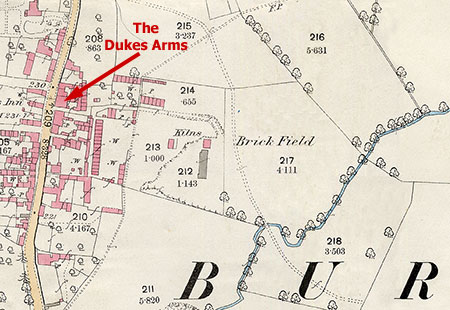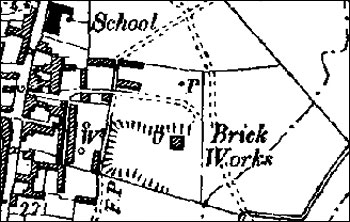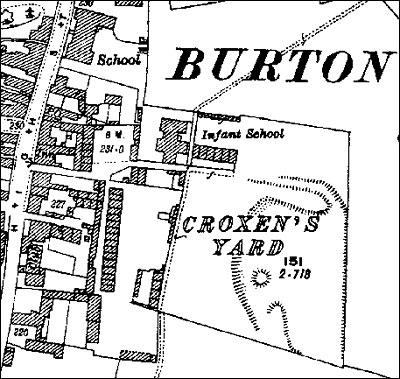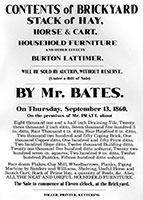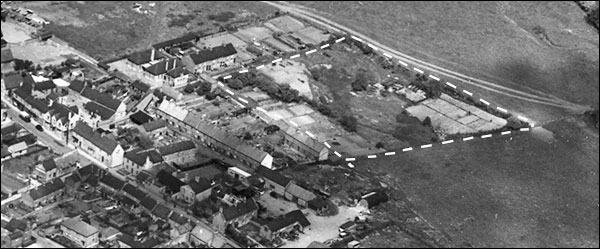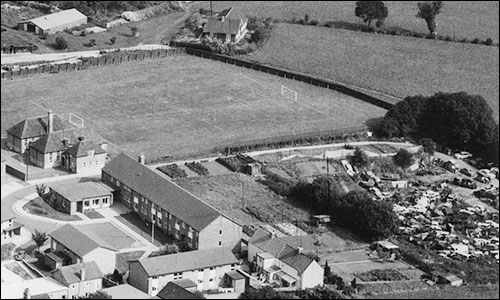| Research by Janet & John Meads, article by John | |||||||||
|
|||||||||
|
|||||||||
|
In 1847, Lewis James of Isham, took out a lease on "One piece of land to be used as a brickyard only, in part of a field in the occupation of John Stokes lying near turnpike road to Higham Ferrers called The Home or Holme Close for fourteen years rent £20 per annum until 1850 then £40 thereafter ........." The land belonged to Henry Richard Harpur and was in the occupation of his tenant John Stokes who farmed from Washpit Farm, which once occupied part of what is now Budgens supermarket site. Furthermore, James undertook to "level the lands when exhausted of clay, laying the soil at the surface in a husbandlike manner so as to render the same fit for occupation for farming purposes, and drain the water from the hollows and put up all proper kilns, sheds and buildings for the carrying on of the trade of a brick and tile maker" James surrendered his lease, and in March 1858, a new lease was drawn up between Henry R Harpur, his tenant John Stokes, and Frederick Pratt of Wilby and John Pratt of Wellingborough, both brickmakers. Similar terms were agreed with an option to purchase adjoining land if required. However, within three years the Pratts had put the contents of the brickyard, with its fixtures and fittings, stock in trade, horse and cart, and household furniture from a house on the site, up for sale as can be seen on a poster advertising the sale. The sale was held on September 13 1860 and the lease surrendered on 12 October. John Croxen, landlord of the nearby Dukes Arms Inn, may have been involved in the business for some time before the sale because he was described as "brick and tile maker" in trade directories starting in 1854, together with John Roddis. The Croxen family seems to have been involved until at least January 1878 when the freehold was offered for sale in an advertisement in the Wellingborough & Kettering News "in the occupation of Thomas Croxen".
Who purchased the brickyard is unclear, but the next identified owner was the successful Burton Latimer businessman Charles Barlow who is named in trade directories as "brick and tile manufacturer" from 1898 until the First World War. The Barlows also owned brickyards in the surrounding area so it is perhaps not surprising that he would take the opportunity to provide local bricks for his rapidly growing home town. Brick maker, brickyard labourer, brick setter, brick burner, flowerpot maker and brickworks machine feeder are occupations that appear in Burton Latimer censuses from 1851 to 1901 as well as in the parish records, but after about 1914 there is no mention of this trade leading me to believe that the business closed down about that time.
Many of the workers lived nearby, and Brickyard Row, Brickyard House and Brickyard Cottage can all be found on the 1918 Electoral Roll; they were not demolished until the 1960s. According to a 1857 inventory, the brickyard premises at that time consisted of two brick and stone built kilns and an adjoining shed, two drying sheds with lathe and other shelving and a complete pug mill. The tiles and bricks were made by hand; probably the only mechanisation would have been the horse-powered pug mill. The pug mill consisted of an upright barrel in which a series of strong iron knives and teeth were caused to revolve by the power of a horse walking in a circular path, so as to cut and masticate the clay very thoroughly as it passed from the top of the barrel to an aperture provided for its removal at the bottom.
Many a small boy (and I was one of them) can verify that the area was ideal for brick making, for the sides of the brook that ran through the field below the brickyard, known as Holland's in my day, were thick with clay and ideal for making dams. Hundreds of happy hours were spent playing in the brook building dams and getting thoroughly wet and dirty in the process. Earlier, in 1906, a more serious childhood prank almost led to the death of a boy who got his head stuck in the pug mill and had to be rescued by his friends, (see transcription of newspaper report at the foot of this page) |
|||||||||
|
The only reminders that the business ever existed are some of the red brick houses that line Burton Latimer's streets, and surviving outhouses with red pantiled roofs and walls with pantiled coping, many of which must have been built using products from the brickyard. The clay pit was used as butts for target practice by the Home Guard during WW2, later as a scrap yard but is now occupied by three houses off
To see a movie of the site being used as a car scrapyard, click here Movie clip kindly loaned by Carol Desborough Serious Accident at
From the
A serious accident befell a lad named Tarry whilst playing in the brickyard at the rear of Croxen's Yard, belonging to Mr. Barlow. The little lad, together with some of his playmates, had wandered into the premises, and coming across a pugmill, used for the purpose of tampering clay, this machine then became the object of their fascination. The machine is rather high, and is driven by a horse with a high shafting from the centre. To get into the machine the unfortunate lad must have been helped, for he is a cripple, and gets about on two crutches. The pugmill has not been used for several months owing to a good supply of bricks being in hand, and it is uncertain whether the machine was free from clay. Someone must have turned the shafting, and the lad Tarry got his head amongst the dull knives and had his scalp terribly crushed. His cries attracted his playmates, who rescued him from his perilous position. He was immediately attended by Dr. Harris, and at once sent to
|
|||||||||
